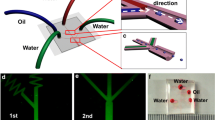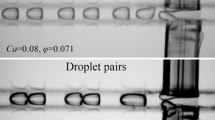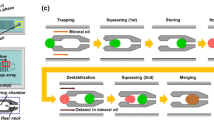Abstract
Droplet microfluidics has been proven to be a viable platform for a variety of reactions by using uniform droplets well encapsulated by an immiscible carrier medium as reaction vesicles. Merging as one of the most basic forms of droplet manipulation is highly demanded in controlling the concentration of reagents for reactions. After preliminary testing of several reported passive merging designs, it is found that most of them are prone to fabrication and operation uncertainties which limit their application for practical use. In this work, we present a simple design for merging variable numbers of droplets with a valve-type function which enables a critical volume limit to be imposed to the final product droplet. When the product droplet reaches the critical volume limit, it will block the exit of the merging chamber serving as the close mode of the valve. As a result, the pressure upstream is built up which forces the product droplet to exit the merger. The relationship between the numbers of droplets merged, the length of input droplets and the length of output droplets is used to tune the design parameters such as the chamber length, pillar array dimensions and bypass channel dimensions according to the desired set of reactions. The simplicity of the design allows for easier design and configuration to a desired purpose and lows down the risk of failures due to fabrication and operation uncertainties. The single-input–single-output design minimizes pressure disturbances from propagating downstream and reduces the complexity of integration into a larger LOC system. The geometry can be scaled up with little to no observable effect on the mode of operation.





Similar content being viewed by others
References
Abate AR, Hung T, Mary P, Agresti JJ, Weitz DA (2010) High-throughput injection with microfluidics using picoinjectors. Proc Natl Acad Sci 107:19163–19166
Basu AS (2013) Droplet morphometry and velocimetry (DMV): a video processing software for time-resolved, label-free tracking of droplet parameters. Lab Chip 13:1892–1901
Boybay MS, Jiao A, Glawdel T, Ren CL (2013) Microwave sensing and heating of individual droplets in microfluidic devices. Lab Chip 13:3840–3846
Bremond N, Thiam A, Bibette J (2008) Decompressing emulsion droplets favors coalescence. Phys Rev Lett 100:024501
Christopher GF, Bergstein J, End NB, Poon M, Nguyen C, Anna SL (2009) Coalescence and splitting of confined droplets at microfluidic junctions. Lab Chip 9:1102–1109
Dewan A, Kim J, Mclean RH, Vanapalli SA, Karim MN (2012) Growth kinetics of microalgae in microfluidic static droplet arrays. Biotechnol Bioeng 109:2987–2996
Frenz L, Harrak AEI, Pauly M, Colin SB, Griffiths AD, Baret JC (2008) Droplet-based microreactors for the synthesis of magnetic iron oxide nanoparticles. Angew Chem Int Ed 47:6817–6820
Garstecki P, Fuerstman MJ, Stone HA, Whitesides GM (2006) Formation of droplets and bubbles in a microfluidic T-junction-scaling and mechanism of break-up. Lab Chip 6:437–446
Glawdel T, Elbuken C, Ren C (2011) Passive droplet trafficking at microfluidic junctions under geometric and flow asymmetries. Lab Chip 11:3774–3784
Glawdel T, Elbuken C, Ren C (2012) Droplet formation in microfluidic T-junction generators operating in the transitional regime. I. Experimental observations. Phys Rev E 85:016322
Gu H, Duits MHG, Mugele F (2011) Droplets formation and merging in two-phase flow microfluidics. Int J Mol Sci 12:2572–2597
Guo MT, Rotem A, Heyman JA, Weitz DA (2012) Droplet microfluidics for high-throughput biological assays. Lab Chip 12:2146–2155
He M, Edgar JS, Jeffries GD, Lorenz RM, Shelby JP, Chiu DT (2005) Selective encapsulation of single cells and subcellular organelles into picoliter- and femtoliter-volume droplets. Anal Chem 77:1539–1544
Hung LH, Choi KM, Tseng W, Tan Y, Shea KJ, Lee AP (2006) Alternating droplet generation and controlled dynamic droplet fusion in microfluidic device for CdS nanoparticle synthesis. Lab Chip 6:174–178
Isgor PK, Marcali M, Keser M, Elbuken C (2015) Microfluidic droplet content detection using integrated capacitive sensors. Sensor Actuat B Chem 210:669–675
Jin BJ, Kim YW, Lee Y, Yoo JY (2010) Droplet merging in a straight microchannel using droplet size or viscosity difference. J Micromech Microeng 20:035003
Kaler KVIS, Prakash R (2014) Droplet microfluidics for chip-based diagnostics. Sensors (Basel) 14:23283–23306
Lee M, Collins JW, Aubrecht DM, Sperling RA, Solomon L, Ha JW, Yi GR, Weitz DA, Manoharan VN (2014) Synchronized reinjection and coalescence of droplets in microfluidics. Lab Chip 14:509–513
Li ZG, Ando K, Yu JQ, Liu AQ, Zhang JB, Ohl CD (2011) Fast on-demand droplet fusion using transient cavitation bubbles. Lab Chip 11:1879–1885
Lin BC, Su YC (2008) On-demand liquid-in-liquid droplet metering and fusion utilizing pneumatically actuated membrane valves. J Micromech Microeng 18:115005
Link D, Anna S, Weitz D, Stone H (2004) Geometrically mediated breakup of drops in microfluidic devices. Phys Rev Lett 92:54503
Liu K, Ding H, Chen Y, Zhao X (2007) Droplet-based synthetic method using microflow focusing and droplet fusion. Microfluid Nanofluid 3:239–243
Liu Z, Ou J, Samy R, Glawdel T, Huang T, Ren CL (2008) Side-by-side comparison of disposable microchips with commercial capillary cartridges for application in capillary isoelectric focusing with whole column imaging detection. Lab Chip 8:1738–1741
Lorenz RM, Fiorini GS, Jeffries GD, Lim DS, He M, Chiu DT (2008) Simultaneous generation of multiple aqueous droplets in a microfluidic device. Anal Chim Acta 630:124–130
Luong T, Nguyen N, Sposito A (2012) Thermocoalescence of microdroplets in a microfluidic chamber. Appl Phys Lett 100:254105
Mazutis L, Baret JC, Griffiths AD (2009) A fast and efficient microfluidic system for highly selective one-to-one droplet fusion. Lab Chip 9:2665–2672
Miller OJ, El Harrak A, Mangeat T, Baret JC, Frenz L, El Debs B, Mayot E, Samuels ML, Rooney EK, Dieu P, Galvan M, Link DR, Griffiths AD (2012) High-resolution dose-response screening using droplet-based microfluidics. Proc Natl Acad Sci 109:378–383
Niu X, Gulati S, Edel JB, deMello AJ (2008) Pillar-induced droplet merging in microfluidic circuits. Lab Chip 8:1837–1841
Song H, Tice JD, Ismagilov RF (2003) A microfluidic system for controlling reaction networks in time. Angew Chemie 115:791–796
Tabeling P (2014) Recent progress in the physics of microfluidics and related biotechnological applications. Curr Opin Biotech 25:129–134
Tan YC, Fisher JS, Lee AI, Cristini V, Lee AP (2004) Design of microfluidic channel geometries for the control of droplet volume, chemical concentration, and sorting. Lab Chip 4:292–298
Tan YC, Ho YL, Lee AP (2007) Droplet coalescence by geometrically mediated flow in microfluidic channels. Microfluid Nanofluid 3:495–499
Trivedi V, Doshi A, Kurup GK, Ereifej E, Vandevord PJ, Basu AS (2010) A modular approach for the generation, storage, mixing, and detection of droplet libraries for high throughput screening. Lab Chip 10:2433–2442
van Steijn V, Kleijn CR, Kreutzer MT (2010) Predictive model for the size of bubbles and droplets created in microfluidic T-junctions. Lab Chip 10:2513–2518
Venkatachalam C, Weidenhof B, Krämer M, Maier WF, Herminghaus S, Seemann R (2010) Optimized droplet-based microfluidics scheme for sol–gel reactions. Lab Chip 10:1700–1705
Wheeler AR, Throndset WR, Whelan RJ, Leach AM, Zare RN, Liao YH, Farrell K, Manger ID, Daridon A (2003) Microfluidic device for single-cell analysis. Anal Chem 75:3581–3586
White FM (1991) Viscous fluid flow, 2nd edn. McGraw-Hill, New York
Xiong B, Ren K, Shu Y, Chen Y, Shen B, Wu H (2014) Recent developments in microfluidics for cell studies. Adv Mater 26:5525–5532
Xu L, Lee H, Panchapakesan R, Oh KW (2012) Fusion and sorting of two parallel trains of droplets using a railroad-like channel network and guiding tracks. Lab Chip 12:3936–3942
Yang L, Wang K, Tan J, Lu Y, Luo G (2011) Experimental study of microbubble coalescence in a T-junction microfluidic device. Microfluid Nanofluid 12:715–722
Yoon DH, Jamshaid A, Ito J, Nakahara A, Tanaka D, Akitsu T, Sekiguchi T, Shoji S (2014) Active microdroplet merging by hydrodynamic flow control using a pneumatic actuator-assisted pillar structure. Lab Chip 14:3050–3055
Acknowledgements
The authors gratefully acknowledge the support from Canada Natural Sciences and Engineering Council of Canada, Canada Foundation for Innovation, Canada Research Chair program and Advanced Electrophoresis Solutions Ltd, through grants to Dr. Carolyn L. Ren. A. Brukson acknowledges the support of Waterloo Institute of Nanotechnology through a fellowship.
Author information
Authors and Affiliations
Corresponding author
Additional information
This article is part of the topical collection “2016 International Conference of Microfluidics, Nanofluidics and Lab-on-a-Chip, Dalian, China” guest edited by Chun Yang, Carolyn Ren and Xiangchun Xuan.
Electronic supplementary material
Below is the link to the electronic supplementary material.
Rights and permissions
About this article
Cite this article
Chen, X., Brukson, A. & Ren, C.L. A simple droplet merger design for controlled reaction volumes. Microfluid Nanofluid 21, 34 (2017). https://doi.org/10.1007/s10404-017-1875-x
Received:
Accepted:
Published:
DOI: https://doi.org/10.1007/s10404-017-1875-x




